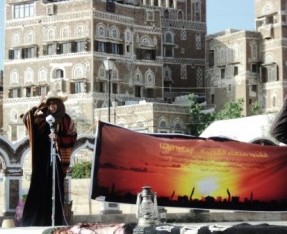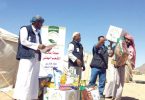
A festival was organized at the open theater in Sana’a to raise awareness about the preservation of the Old Sana’a city and keep it on UNESCO’s World Heritage list
By Jihan Anwar
UNESCO’s threat to take Sana’a’s Old City off the list of World Heritage sites led to demonstrations and a festival in order to raise awareness among Yemenis about preserving that 2,500 year-old area.
The Old City was declared a World Heritage site in 1986 by UNESCO. The walls surrounding the old city defined the borders of Sana’a until the end of the Imamate period; the streets and centuries-old houses built there were preserved virtually intact until then.
Starting in the 1970s, however, urban expansions threatened to damage and even destroy many of the historical buildings. The General Organization for the Preservation of Old Sana’a was established in 1984 to tackle this issue and it later expanded to become the General Organization for the Preservation of the Historic Cities of Yemen (GOPHCY).
Yet, numerous violations of the UNESCO agreement have been registered, with modern style or cement based constructions being built in the area.
The Old City has about 100 mosques and 6,500 homes. The Great Mosque, built during the 6th year of the Prophet’s Hijrah (migration from Mecca to Medina), is more than 1,400 years old. Bab al Yemen (Gate to Yemen), is 1000 years old.
Apart from their historical value, the buildings in the Old City have an additional peculiarity. They have been built by quarried stones, with a mix of naturally insulating material. Stone is used in the making of the lower levels while upper ones are characterized by bricks with clay insulation. The technique used to construct the buildings was carefully studied millennia ago by Yemenis so that the houses retained heat during the day and released it at night, eliminating the need for power generated heaters or ventilators.
The event was organized by Brooj Al Ammari, an architecture student. “There is a clear negligence and ignorance about the preservation of the Old City, both by the part of the government as well as the residents themselves. There should be people responsible for monitoring and preserving certain areas so they can be held accountable,” said Al Ammari.
The festival was preceded by a march through the Old City by youth wearing traditional Yemeni clothing. They held signs that called for the preservation of the city. The open theatre next to al Saila in which the event was held, was decorated by pictures of the Old City and traditional Yemeni handcrafts. The festival itself featured Sana’ani dances, songs and acting. In the festival traditionally dressed host served Yemeni coffee to attendees.
Al Ammari says that Yemen’s ongoing conflicts and events, including the National Dialogue Conference, leave people wondering whether preservation is a sufficiently important topic for the moment. “Yet, once irreparable damages are done to the city, there will be nothing left to do and people will wonder why preventive actions weren’t taken earlier.”


